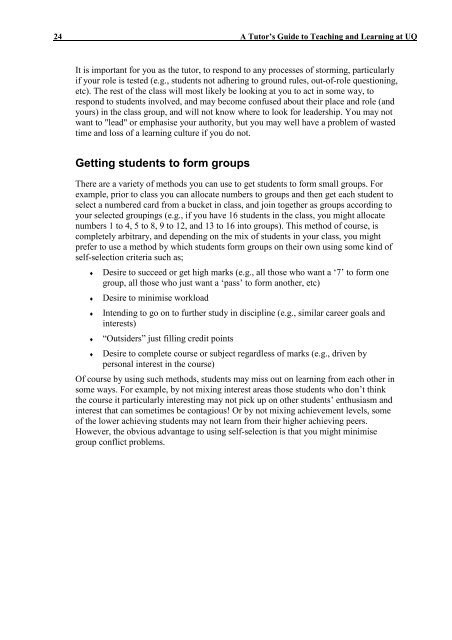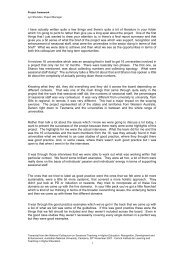A tutor's guide to teaching and learning at UQ - TEDI - University of ...
A tutor's guide to teaching and learning at UQ - TEDI - University of ...
A tutor's guide to teaching and learning at UQ - TEDI - University of ...
You also want an ePaper? Increase the reach of your titles
YUMPU automatically turns print PDFs into web optimized ePapers that Google loves.
24 A Tu<strong>to</strong>r’s Guide <strong>to</strong> Teaching <strong>and</strong> Learning <strong>at</strong> <strong>UQ</strong>It is important for you as the tu<strong>to</strong>r, <strong>to</strong> respond <strong>to</strong> any processes <strong>of</strong> s<strong>to</strong>rming, particularlyif your role is tested (e.g., students not adhering <strong>to</strong> ground rules, out-<strong>of</strong>-role questioning,etc). The rest <strong>of</strong> the class will most likely be looking <strong>at</strong> you <strong>to</strong> act in some way, <strong>to</strong>respond <strong>to</strong> students involved, <strong>and</strong> may become confused about their place <strong>and</strong> role (<strong>and</strong>yours) in the class group, <strong>and</strong> will not know where <strong>to</strong> look for leadership. You may notwant <strong>to</strong> "lead" or emphasise your authority, but you may well have a problem <strong>of</strong> wastedtime <strong>and</strong> loss <strong>of</strong> a <strong>learning</strong> culture if you do not.Getting students <strong>to</strong> form groupsThere are a variety <strong>of</strong> methods you can use <strong>to</strong> get students <strong>to</strong> form small groups. Forexample, prior <strong>to</strong> class you can alloc<strong>at</strong>e numbers <strong>to</strong> groups <strong>and</strong> then get each student <strong>to</strong>select a numbered card from a bucket in class, <strong>and</strong> join <strong>to</strong>gether as groups according <strong>to</strong>your selected groupings (e.g., if you have 16 students in the class, you might alloc<strong>at</strong>enumbers 1 <strong>to</strong> 4, 5 <strong>to</strong> 8, 9 <strong>to</strong> 12, <strong>and</strong> 13 <strong>to</strong> 16 in<strong>to</strong> groups). This method <strong>of</strong> course, iscompletely arbitrary, <strong>and</strong> depending on the mix <strong>of</strong> students in your class, you mightprefer <strong>to</strong> use a method by which students form groups on their own using some kind <strong>of</strong>self-selection criteria such as;♦♦♦♦♦Desire <strong>to</strong> succeed or get high marks (e.g., all those who want a ‘7’ <strong>to</strong> form onegroup, all those who just want a ‘pass’ <strong>to</strong> form another, etc)Desire <strong>to</strong> minimise workloadIntending <strong>to</strong> go on <strong>to</strong> further study in discipline (e.g., similar career goals <strong>and</strong>interests)“Outsiders” just filling credit pointsDesire <strong>to</strong> complete course or subject regardless <strong>of</strong> marks (e.g., driven bypersonal interest in the course)Of course by using such methods, students may miss out on <strong>learning</strong> from each other insome ways. For example, by not mixing interest areas those students who don’t thinkthe course it particularly interesting may not pick up on other students’ enthusiasm <strong>and</strong>interest th<strong>at</strong> can sometimes be contagious! Or by not mixing achievement levels, some<strong>of</strong> the lower achieving students may not learn from their higher achieving peers.However, the obvious advantage <strong>to</strong> using self-selection is th<strong>at</strong> you might minimisegroup conflict problems.



